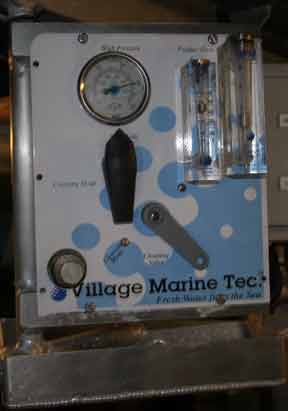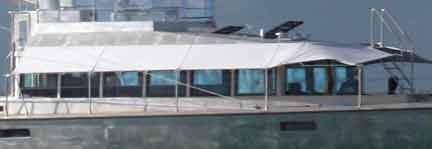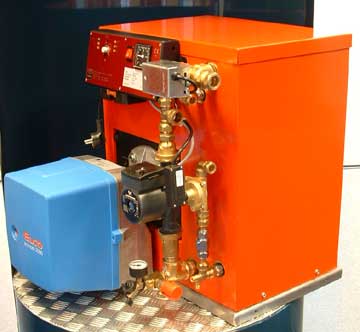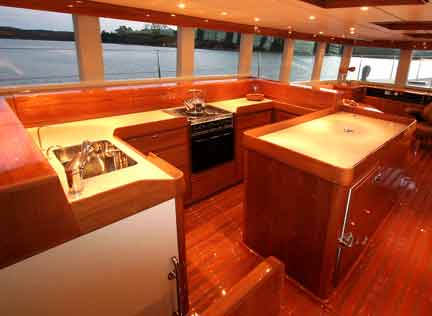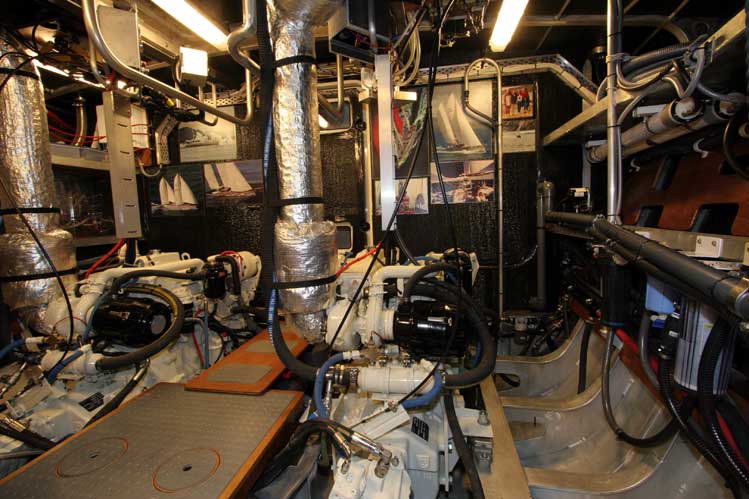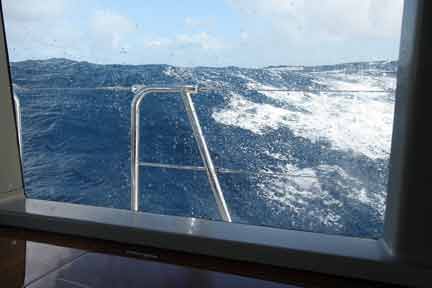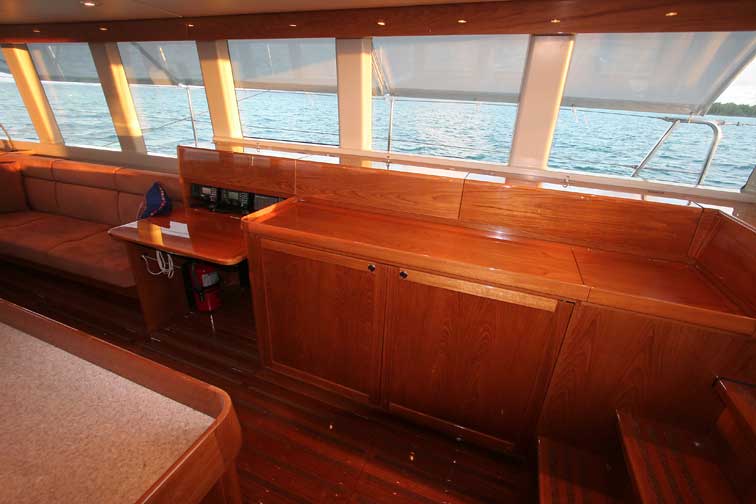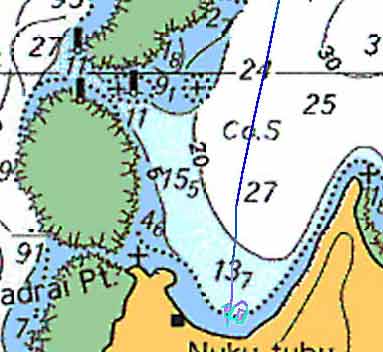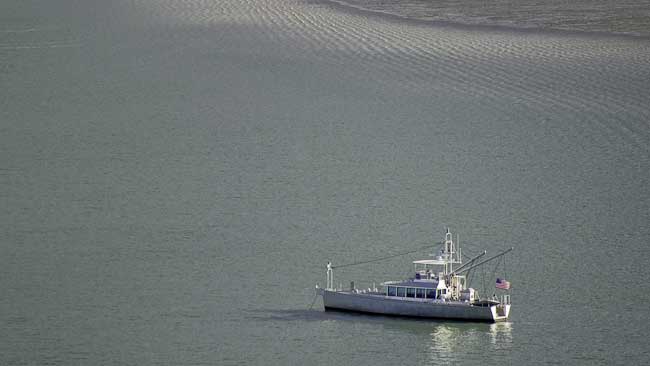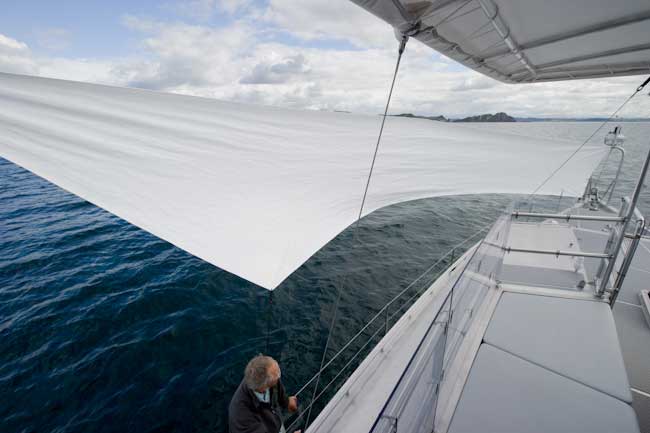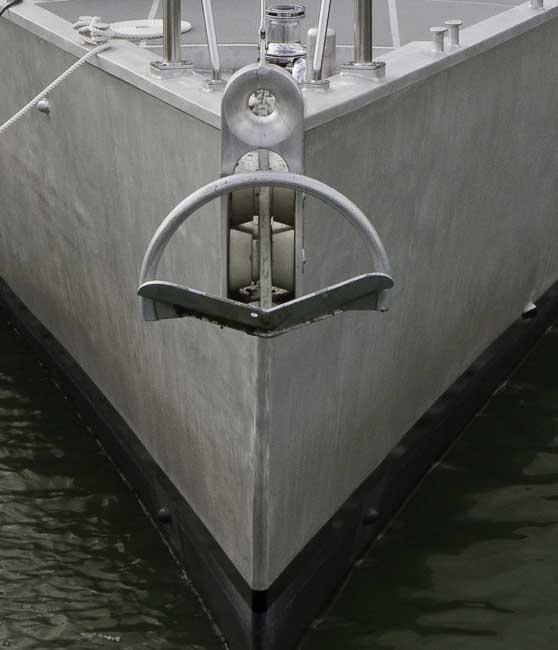Archive for 2011
A Shifting View Of Cruising

In 2003 when we began work on the first FPB, Wind Horse, we briefly considered an enclosed flying bridge. Our good friend, and collaborator, the late Steve Davis, was a strong advocate. He said “one day you will come around.”
Our reasoning was that in conditions warranting enclosure we’d pilot from the great room, and when it was pleasant, from above. A major part of the decision was poor visibility through the plastic windows.
Things have changed.
A New Look Wake For Wind Horse
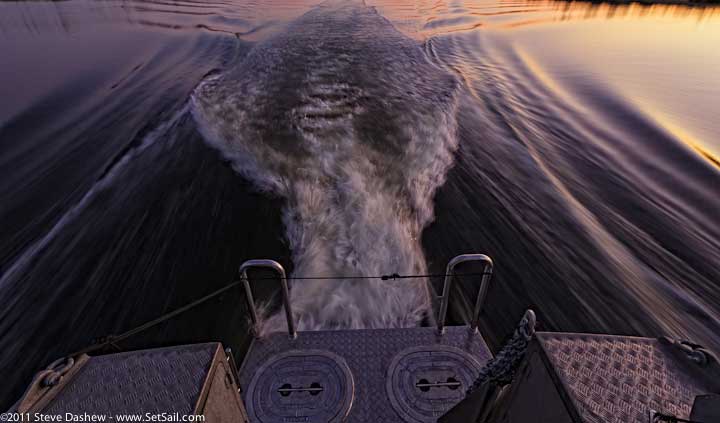
We are through with phase one of our work list on Wind Horse, and have been out testing the changes. The photo above was taken at dusk today, coming back down the Intra Coastal Waterway to the Jarrette Bay facility where Cory McMahan has his Triton Marine operation. Wind Horse is within two tons of full load, the water depth is 13 feet (four meters) and we are running at 1400 RPM, roughly nine knots.
Considering the slow speed (for us), and the water depth, this is an exceptionally clean wake release off tne new transom extension.
How To Make An Angled Cut With A Hole Saw

You are looking at a simple, but very effective jig for making angled cuts with a hole saw. This is the brainchild of Cory McMahon of Triton Marine. We were in the process of installing a fresh water pick up for the new air conditioning cooling system when Cory suggested this to Chris Martin.
Hammering Away On The List
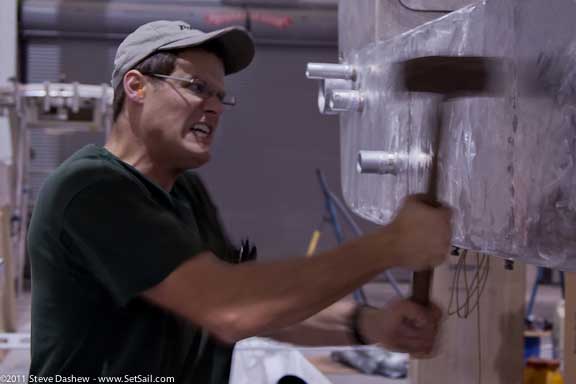
We are hammering away on the list, literally as you can see above (that is Eric from Bausch American) and figuratively. Although it looks like chaos, we are getting things done. The stern extension is now welded on, with a short list of items to deal with before it is finished.
Solar Array – Final Layout (Really)

We’re out of time, which is a good thing since it forces a decision on the solar array, hence this post. What you see in these images is what we’ll be looking at from the dinghy, the view with which we are most concerned.
The Mud Room and A New Roof For The Flying Bridge
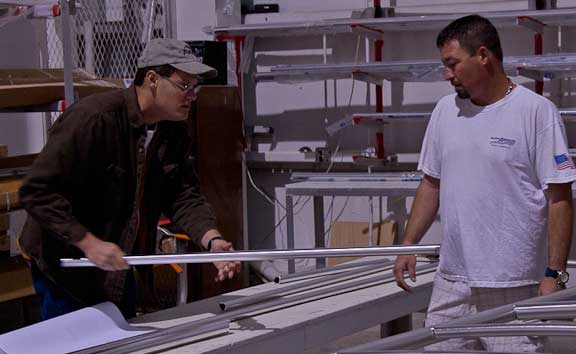
One of the things which attracted us to the Jarrett Bay Marine Park here in Beaufort was the work we saw at Bausch American. Their specialty is towers for sports fishermen, so they are used to working with aluminum. We came in with a couple of mods in mind, but as we have gotten comfortable with their standard of work and efficiency, our list has grown.
A Few Thoughts After 57,000 Miles
We’ve been through the drive line and are about to reassemble things, have checked the tanks, and the rest of the systems, with very little wear and tear to show for our 5700 hours and 57,000 miles +/- of travel. As we’ve done a series of posts scattered here and there on this subject, perhaps a recap is in order. We’ll then give you a brief rundown on changes we are making and why.
But first, a few thoughts on maintenance, frustration, and costs of ownership. Read the rest »
Happy Thanksgiving
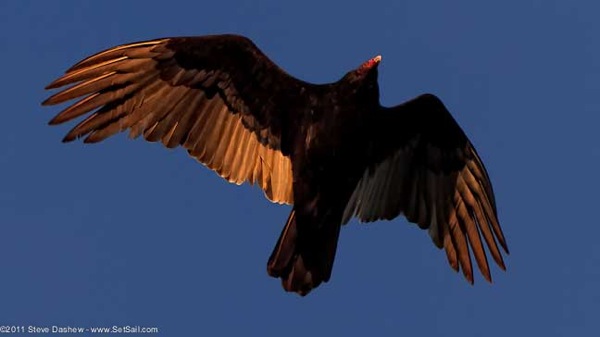
From the crew at SetSail and Dashew Offshore we wish all of you a happy Thanksgiving.
Post script: the soaring machine above is a Cathartes aura, lovely to watch in the air, but we’re not sure how it would go with cranberry sauce and stuffing tomorrow.
A Different Approach
“Whatever the conditions, disciplines and concepts learned through years of high-energy ocean sailing have led them to create an ‘unsail’ boat that should serve them very well.”
–Seahorse Magazine
Our approach to the marine business is a little different. We don’t do a lot of projects.
FPB 64 Construction Update November 18, 2011
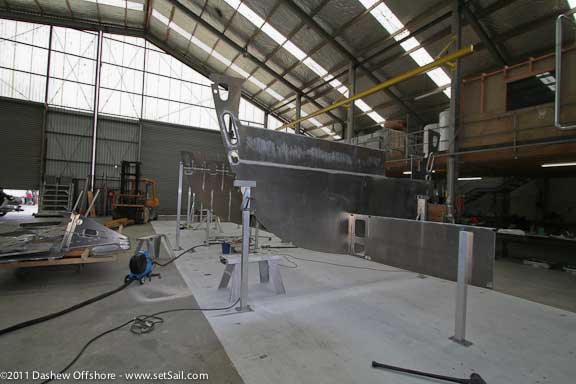
Since we’ve been boring you with technical posts all week why change the rhythm? These photos are from Friday, and cover FPB 64s five through seven. We’ll start with seven, shown above, the skeleton of which is just starting to be assembled.
Cool Tools From Lowes
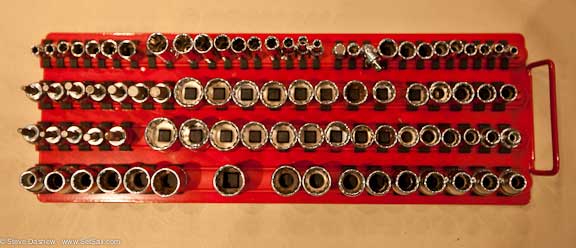
Last Sunday we took the afternoon off from Wind Horse and journeyed to the metropolis of Moorehead City. On the way we spied a Lowes, and needing nylon cable ties stopped for a few minutes. There was a tool department near the entrance of course, and as designed, were were drawn to the shiny rows of goodies.
What Should A Diesel Tank Look Like after 40,000 Gallons (170,000 liters)..
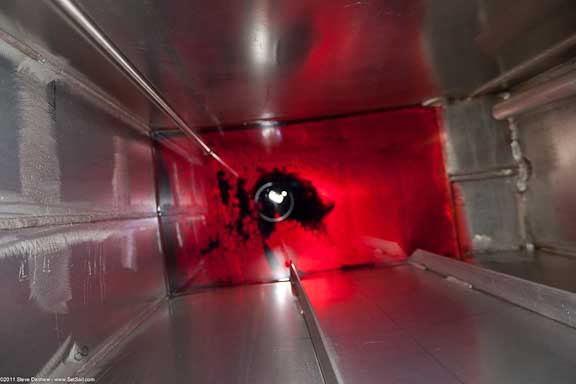
Corey McMahon and cohorts have been working on “the list” and this afternoon’s feature was an inspection of the diesel tanks. After 5700 hours of engine time over 6.5 years, and more than 40,000 US gallons (170,000 L) of diesel, sourced all over the world, we were more than a little curious as to what we would find.
Welding Cautions On A Completed Yacht
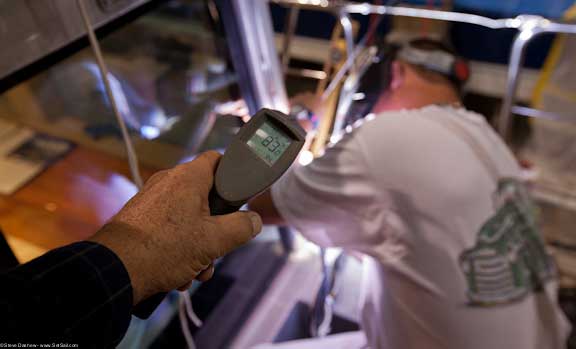
One of the great things about metal yachts is the ease of making structural connections in a totally watertight fashion, by welding. When this takes place on a completed vessel certain cautions need to be observed.
5700 Hours Of Shaft Wear
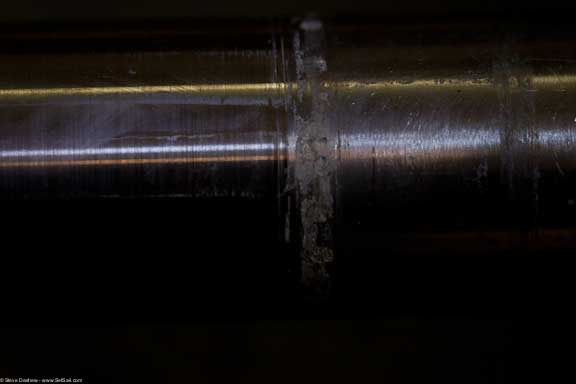
The prop shafts have been removed (they slide past the rudders) and we’ve given them a close look. The cutlass bearings are both still within tolerance, with the starboard bearing showing no wear. The port bearing has on the order of 1/8″ (3mm) of slop, not much really.
However, we are replacing both since the shafts are now out. The shafts show almost no cutlass bearing where.
Checking The Drive Line After 5700 Hours
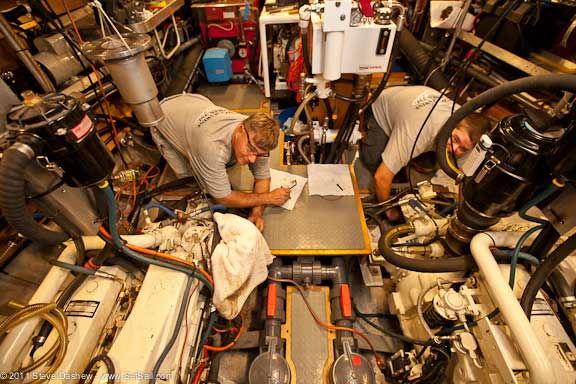
Corey (left) and Casey (right), from the Triton Marine crew, head down and tails up, taking the drive lines apart on Wind Horse. After 5700 hours we want to have a detailed look at the various elements to see how they are wearing.
Debbie Rossin (the real Iron Lady) On FPB Cruising
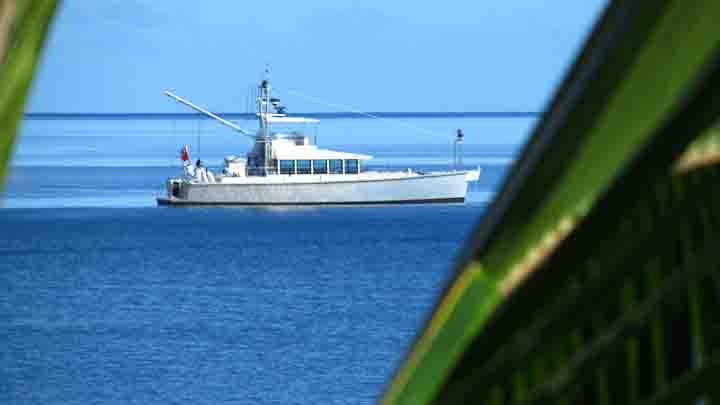
After some 5000 cruising miles since delivery in March of 2011, I have some pretty specific thoughts on how Iron Lady is working out. Some were surprises to me. At the top of the list was that I felt safe on Iron Lady. While I can’t necessarily identify all the features that make the boat safe, between how comfortable the boat is at sea, at anchor and how it stood up to the punishment of a grounding all gave me tremendous confidence in the boat. My husband is also much more relaxed about things and that, in turn, makes me comfortable. My other comment was that I never would do what we have done on Iron Lady on our last boat. By the second day out of New Zealand to Tonga on our first really long passage, I was standing watch – something I would never on our last boat.
Chesapeake Schooner Race
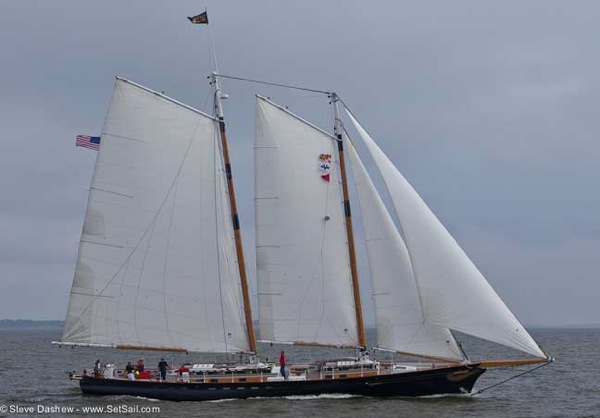 As we were heading down the Chesapeake from Whitehall Creek we noticed a large group of schooners milling about. Turns out this was the day for the annual schooner race. The photos which follow are fun to study, and there are a couple of rig items worth noting. We’ll start with this derivative of the schooner America. Read the rest »
As we were heading down the Chesapeake from Whitehall Creek we noticed a large group of schooners milling about. Turns out this was the day for the annual schooner race. The photos which follow are fun to study, and there are a couple of rig items worth noting. We’ll start with this derivative of the schooner America. Read the rest »
Aluminum Hulls, Zincs, and Corrosion Control

Over the last 30 years we’ve been involved in many aluminum and fiberglass yacht construction projects. Our experience has been that properly built, aluminum holds a substatial edge overall in maintenance issues. “But what about corrosion, and the horror stories that are rumored?” you might be thinking.
To anwser that we offer the photos above and below. Those are sacrificial zincs, formerly attached to the hull of Wind Horse as sacrificial anodes, so that any corrosion comes off their mass rather than the hull.
FPB 64 Lucky Day At Circa
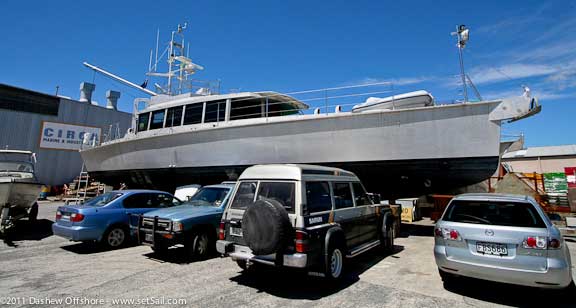
It is the eleventh day of the eleventh month in the year 2011, and we have a new batch of photos from Circa, a few of which we’ll share. That’s Avatar, FPB64-1 in the yard, back at her birth spot for a get home auxiliary to be installed. After two years of cruising and many thousands of miles she is looking good. FPB 64-3, Iron Lady, is in the area as well. And then there are FPB 64s five, six, and seven, under construction, which we shall get to shortly.
Wind Horse Solar Array – Final Location (Updated)

Sometimes an idea that seems great in abstract fails when you get into detailed drawings. Such is the case with our solar roof, now history. But as cool as it might have seemed (to some) we have a much better solution.
Wind Horse Engine Sound Level – Shooting For Silence
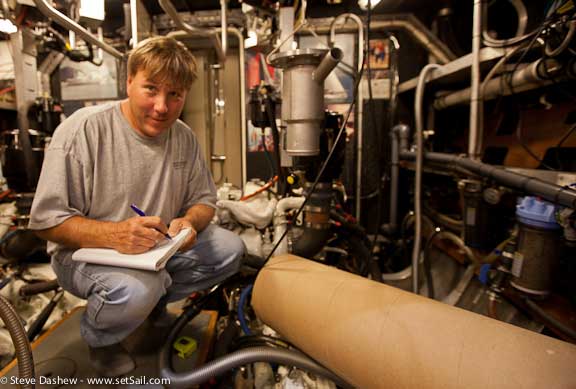
An often overlooked benefit of propulsion efficiency and its reduced power demands is a quieter engine system. But as quiet as Wind Horse is under power, 57 dB at eleven knots, one of our goals for this haul out is to reduce the sound level further. Of course when you are at 57dB already, further reduction is not easy. The swim step extension will move the exhaust three feet /90cm further aft, and underwater, which will help – a lot. In addition, we are changing the exhaust system inside the engine room, hoping for major improvements here as well.
Solar Roof For The Flying Bridge? Maybe

The rendering above shows the proportions of a solar roof for the flying bridge (support is not yet shown, but will be required). The efficiency and cost per watt have gotten to the point where this may make sense. In the scheme above there would be eight 250 to 320 watt panels, depending on what we find next week. This is enough to generate a large chunk of our daily power usage at anchor. But is it worth the expense and hit on aesthetics?
Favorite Weather Ipad Apps, Seamanship, and We Ought To Know Better
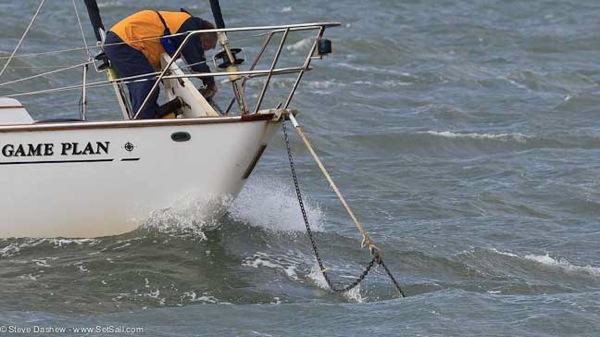
From the photo above, taken in the lagoon adjacent to Cape Lookout in North Carolina’s Outer Banks, you can see there is a bit of breeze. In fact, this breeze woke us up at 0400 with the wind shift, meter high waves, and bumping the bottom wih the keel. Coastal cruising, in a country with as much weather data as the USA, there is no excuse for getting caught by weather, We’ll come back to this subject and preparation for adverse situations, later.
Right now we want to chat about a couple of inexpensive IPad Apps that work really well f or local weather.
A Bottom Paint That Works, and Ready To Start “The List”
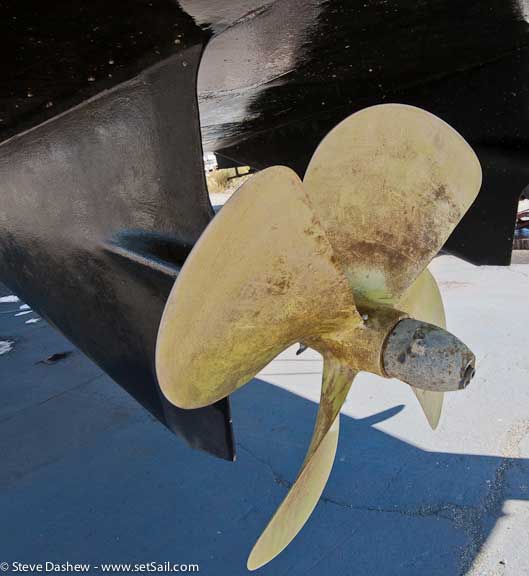
We’ve been hauled by Jarrette Bay and the first order of business is an inspection of the bottom. We are not displeased with what we see. Starting with the props, painted with “Prop Speed” four months ago, and they look very clean.
What A Clean Running Engine Exhaust Looks Like after 50,000+ Miles
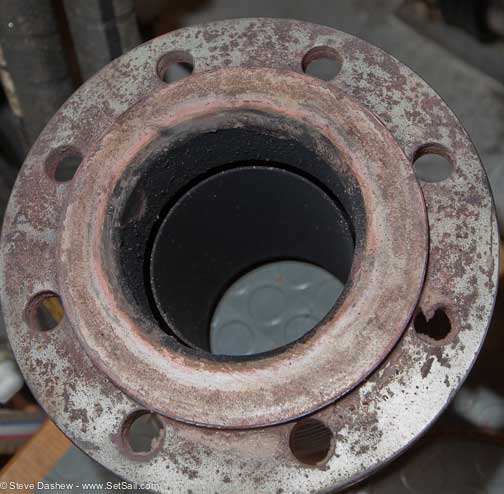
Wind Horse now has 5700+ hours on her two little John Deere diesels, over 50,000 nautical miles of cruising the oceans. If you have looked at “experienced” exhaust systems, you will know that an exhaust this clean after almost 6000 hours is the exception rather than the rule.
Wave Size Probability
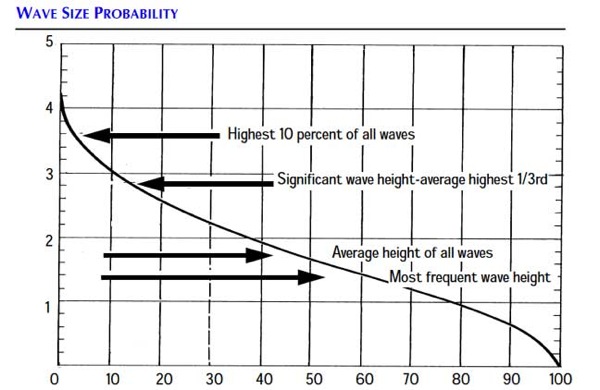
We were just talking about significant one third highest wave heights and how this compares to what you may encounter. The graphic above and photo below are a partial explanation from Mariner’s Weather Handbook (the link will take you to the table of contents)
Meteorological Bomb Coming?
“Hi Steve. Speaking of storms and weather patterns what do you think about the low off the east coat. Looked ominous on the surface charts and even more so on the 500 mb charts. Some weather sites are calling it a low pressure “bomb”. I have read your Mariners Weather Handbook a few times through and this system seemed like a good learning opportunity.”
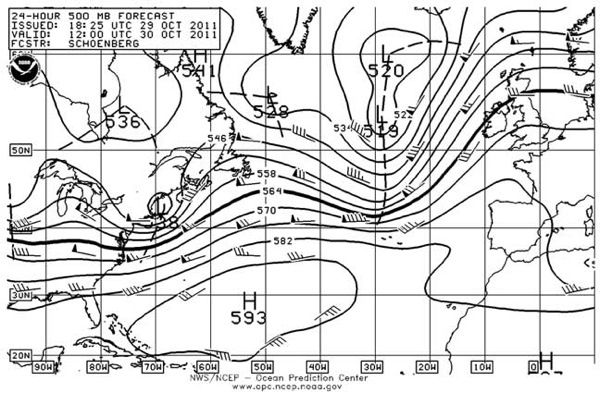
Thanks for the heads up, Mike:
For anyone interested in weather, this is what gets the adrenalin flowing at the Ocean Prediction Center. Right now this is just a hurricane strength storm forecast, bad enough if you are caught in it,
FPB 64 – Going Smoothly

While our usual fair is more extreme weather than this video depicts, there are some lessons for us here as well, not the least of which is the efficiency at work you are about to watch on your computer screen. The video was shot by Brian Rickard on a recent cruise with the Henrys aboard the FPB 64 Sarah Sarah, in British Columbia.
Sarah Sarah has a full payload of the Henry’s gear aboard and half tanks. She weighs around 80,000 pounds / 36,000kg, and is running at nine knots through the water (net of current). This is a speed length ratio of 1.15, on the low side of where the FPB 64s normally operate in smooth water.
Wind Horse – Time For Some Pampering
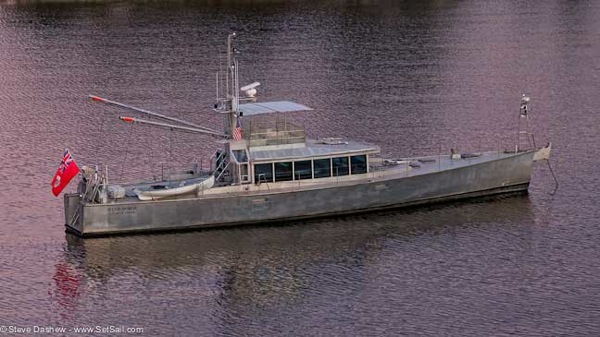
Wind Horse has finished her seventh season of cruising, there are 5600 hours on her engines, and more than 50,000 miles have passed under her svelte canoe body. She has traveled from New Zealand to Alaska, through Panama to Greenland, across the North Atlantic to the British Isles, and cruised Norway to Svalbard and the Arctic ice pack to within 600 miles of the North Pole. She has coasted Spain, been with the glitterati in the Balearic Islands, and set a record in the ARC from the Canary Islands to the Caribbean, that could stand for a long time. She made it fom Las Palmas to St. Lucia (across the Atlantic) to Fort Lauderdale, Florida, and on to Marathon without stopping for fuel. This year has been less ambitious, with just the East Coast of the US to Maine and back on the itinerary. All of this in comfort, with minimal maintenance, and a very limited list of gremlins.
So, we think Wind Horse is due for a bit of pampering.
Fiji To New Zealand – FPB 64-1 Avatar Picks Up Some Valuable Force Nine Data
![]()
The passage from the tropical South Pacific island nation of Fiji, south to New Zealand, is one of the more difficult you will find. There is a high risk of heavy weather, sometimes extreme, that every year catches a few yachts. Obviously it is best to avoid this form of unpleasantness. The key is boat speed, understanding weather, and patience. But even the professionals occasionally get caught so it is advisable to be prepared.
This was the case last week with FPB 64-1 Avatar. During her passage to New Zealand she had two days of force eight gales on the nose, gusting force nine (35 to 40 knots gusting 49). As much as we’d have preferred for Avatar and crew to have an easier trip, these conditions generated exceptionally valuable data, as we shall shortly see
Hull Efficiency And Dolphins
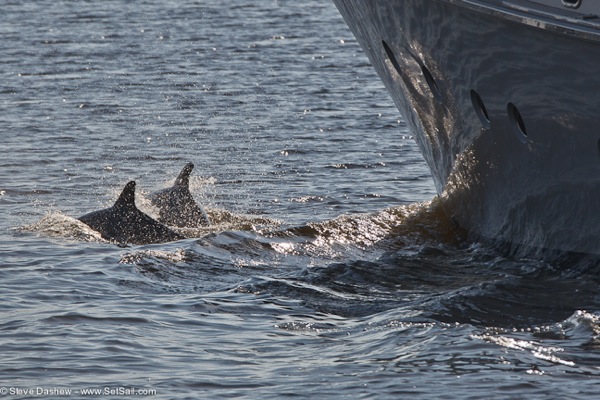
We were tied up at the Jarrett Bay boat yard complex yesterday, doing a bit of preliminary planning with Corey McMahon who will be handling our seven year itch list, when a couple of interesting photo ops passed by. There is a pod of dolphins hanging out off the docks and occasionally riding bow waves (it is hard to concentrate on boat project dialog when the pod is playing in the background).
What was interesting is the boats whose bow waves they chose to ride. There appears to be direct correlation between hull efficiency, or lack there of, and the dolphin’s favorites.
Heading South With The Crowd
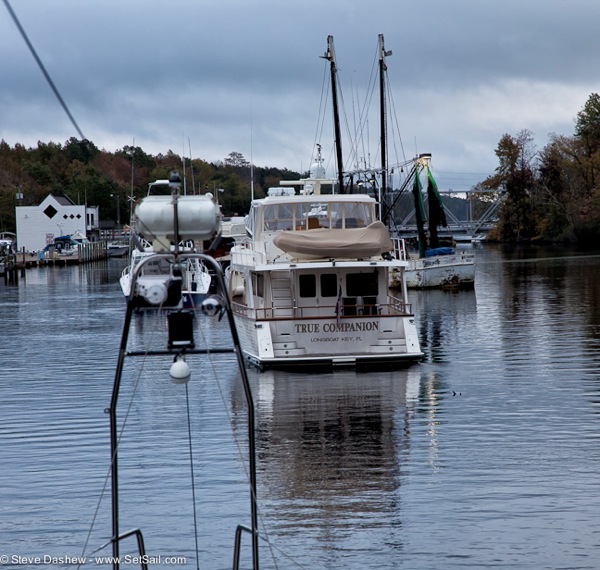
We’re on our way south, with the crowd. At the beginning of the Intra Coastal Waterway, Great Bridge, near Norfolk, Virginia, things are a bit crowded. But they quickly thin out, and for the most part we’ve been able to find the quiet waterways and anchorages which are to our liking.
FPB 64-5 Get Home Auxiliary – The Tradeoffs
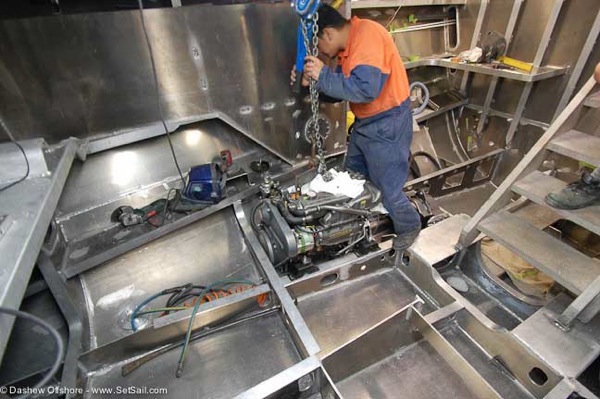
We are just back from a quick trip to New Zealand to check on the engine room layout now that a get home system is being added to the FPB 64s. Those of you who have been aboard one of the FPB 64s knows the engine room is a work of art. Circa, our clients, and ourselves are concerned that the hit on engine room access and aesthetics be minimized with this extra diesel.
Hull Shape, Displacement, and Boat Speed
“I witnessed first hand how well the boat handles up-swell at various speeds.”
–Bill Parlatore, Passagemaker Magazine
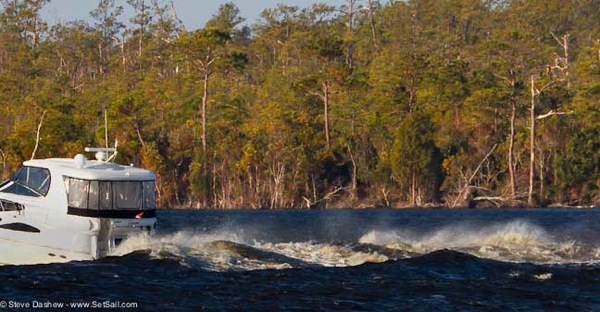 Sitting here at anchor off to the side of of the Intra Coastal Waterway affords the opportunity of studying hull shapes and their wave trains. What we have for you here are several different shapes, each with a unique shape to their disturbance pattern. The boat above is about 35-feet long and is throwing a huge wake, not a sign of efficiency! Read the rest »
Sitting here at anchor off to the side of of the Intra Coastal Waterway affords the opportunity of studying hull shapes and their wave trains. What we have for you here are several different shapes, each with a unique shape to their disturbance pattern. The boat above is about 35-feet long and is throwing a huge wake, not a sign of efficiency! Read the rest »
Contacting Dashew Offshore
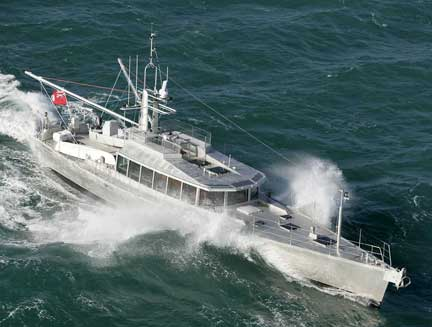
You can contact Dashew Offshore via e-mail at DashOff@setsail.com.
Predicting Performance Under Power – Albemarle Prop Test
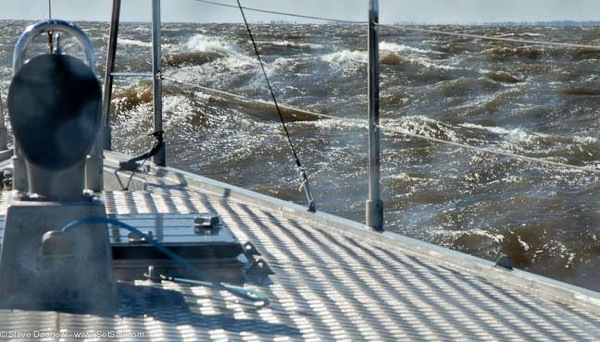
Predicting performance under power is relatively simple if you have a hull form that fits standard models (the definition of standard here covers a gamut of fishing trawlers to high speed destroyer hulls). In the olden days you would look up David Taylor model test data for something similar and then go to work with your slide rule. More recently, this process has become quicker, with the ubitquitous computer filling in for the retired slide rule. But if you pick the wrong model data, or miss something in your hull characteristics, the resulting calcs can be off, sometimes by a lot.
The Ultimate Sailing Cruiser
“The new Dashew passagemaker draws much of its heritage from the high-performance sailboats for which the Dashews are well known. The last of that evolution of sailing yachts was Beowulf, a 78-foot ketch in which Linda achieved the family speed record: surfing at 32.7 knots down waves far offshore.”
–Bill Parlatore, Passagemaker Magazine
Of all the sailboats we’ve done over the years, Beowulf is our favorite.
Details
“…the interior joinery is absolute perfection.”
–Sea Spray Magazine
We’ve gathered together a selection of photos covering some of the boats we’ve built over the past 25 years.
35 Years Chasing the Dream
“Perhaps better known for his Deerfoot, Sundeer, and Beowulf offshore sailing vessels, which are known and respected for being capable of comfortable, long offshore passages with a crew of two, [the FPB] represents a somewhat completely different tack, so to speak.”
–Northwest Yachting Magazine
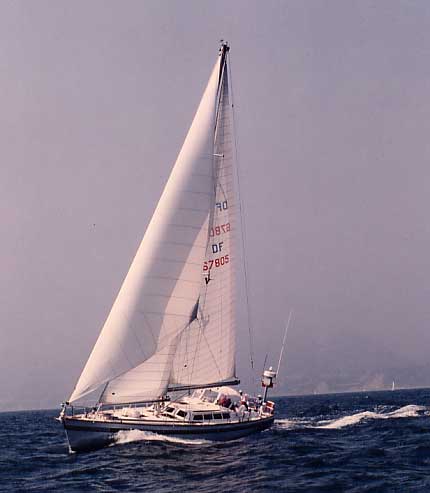
Following is a sampling of the boats that we’ve designed and built over the past 35+ years.
Welcome to Dashew Offshore

If you have been working down this website from the top you are probably overflowing with technical data. If there is any bandwidth left, a few words on Dashew Offshore and its history may be of interest.
Directional Control
“Wind Horse is well behaved. She tracks straight. The autopilot gain is set to its lowest level and we find our own way down the waves, showing us occasional bursts to 20 knots.”
–Yachting World Magazine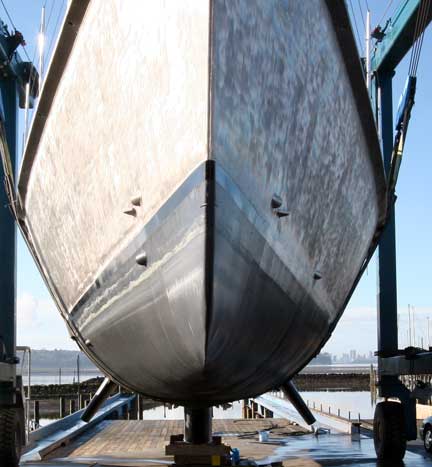
Most cruisers dream about trade wind passages: long periods with the wind and seas on the quarter, steady winds, and beautiful puffy clouds. But in the context of being comfortable at sea, trade wind sailing is often less desirable than other angles.
Domestic Water System
Our approach to domestic water systems has evolved over the years, with the introduction of ever more efficient reverse osmosis watermakers.
Air Conditioning Specifications
Air conditioning specifications always involve a lot of tradeoffs.
Active Stabilizers
Of all the issues facing us during the design of this boat, none was more important than the approach to stabilization.
Domestic Heating & Hot Water
Of all the systems aboard our boats none is more important than good heating for the interior, and an efficient supply of hot water for bathing.
Fridge System – A New Approach
This is the first time we have not used a holding plate system in the fridge and freezer. We took this approach as on paper it appeared more efficient.
Electrical Systems
 Over the years we’ve been able to fine tune our approach to onboard electrical gear.
Over the years we’ve been able to fine tune our approach to onboard electrical gear.
The Drive Line
In this section we’ll cover the components of the drive line: engine, transmission, thrust bearing and CV axle, and props.
Systems
The heart of any cruising vessel – sail or power – is in its systems. It is the systems that bring you ambiance and pleasure (and, if not done correctly, a load of frustration).
Wye River, Eastern Shore of the Chesapeake

Weather that has folks scurrying for cover often holds the most dramatic impact. If you happen to be anchored in a totally protected body of water, with the pick well dug in, you can concentrate on soaking up the view.
Stability, Comfort & Capsize Resistance
The ultimate safety test for any vessel bound offshore is how well it resists capsize. Many factors enter into this equation.
Laundry Facilities
In the past we’ve used combination washer-dryers because they are compact and easy to work into the interior.
Ship’s Office
We need a fair amount of office space, as we are often at work when while we are cruising. (Although it is better to just cruise!)
Nav Station / Bridge Layout
The layout of the saloon is developed around the concept that we primarily passage with just two of us aboard, and we prefer that watch keeping, working in the galley, and just plain hanging out occur in the same area.
Staterooms
Forward Suite
There are several ways of looking at the design premise for the owner’s “suite”.
To Paint Or Not To Paint That Is The Question
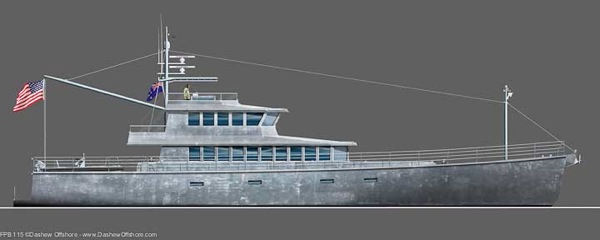
We love the visually textured finish of bare aluminum. The way light plays on the surface presents an ever changing canvas, never boring, always something a little different, elegant in an understated way. But if you are new to the look it can take a while to fall in love with the appearance (it is much easier to become enamored with the wonderful benefits). Almost everyone likes the shiny new finish. The issue, if there is one, comes as the aluminum goes through a natural aging process, and the shine dulls. The profile view of the FPB 115, above, has its surface finish picked up from a photograph of Wind Horse when she was just launched. We have other versions following with a paint job for comparison.
Galley
The galleys on our previous designs have worked extremely well, providing excellent storage, good counter space, and ease of use at sea. This galley goes a step beyond.
Interior Layout
We’ve been refining our approach to cruising interior design for the last 28 years – we’re at the point where we have a pretty good handle on the combination of features required for comfort at sea and in port.
The Swim Step
We first started putting swim steps on our designs in 1978. Initially they were a safety device, a way to make man overboard recovery easier.
Roll Control at Anchor
At anchor, when waves are more or less on the beam, all boats begin to roll, while comfort rapidly deteriorates.
Working on Deck
There are six scenarios working on deck, each of which is considered for both layout and hardware specification.
Tactics For Dealing WIth Groundings – A Reevaluation
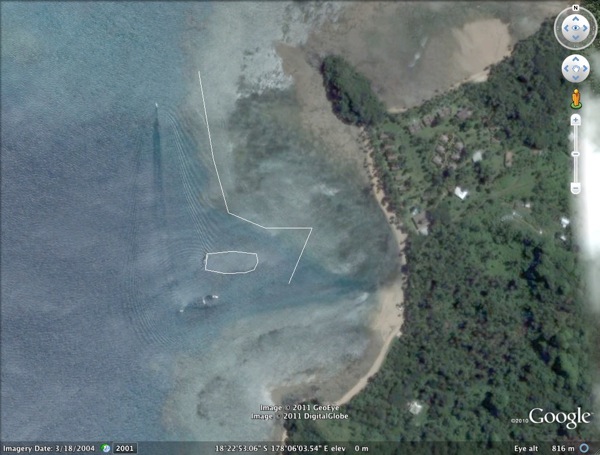
A while ago we wrote up the details on the FPB 64 Iron Lady’s interaction with a Fijian Reef. She is in New Zealand now, hauled out near Circa, and we’ve been studying the photos and talking to her owner, Pete Rossin, to get a better feel for the conditions. What we have learned has caused us to rethink our normal tactics when aground in difficult situations for the FPB 64s.
Tropical Considerations
Cruising in the tropics brings with it a special set of requirements because of the heat and humidity.
Flying Bridge
The flying bridge has become one of our favorite places at anchor and when on passage in pleasant weather.
FPB 64 – The Next Step
We’ve been involved with the design and construction of ultimate cruising yachts for almost three decades.
FPB 64 – Factors of Safety
As you go to sea, you probably harbor in the back of your mind the particular weaknesses of your vessel. If unfavorable weather is forecast, it is often these weaknesses, coupled with a lack of confidence that create tension, concern, and fear.
FPB 64 – Structure
The hull, deck, and house structure for the FPB 64 are engineered to our normal high standards, with exceptional factors of safety.
Range Under Power

There are all sorts of ways of calculating fuel burn and range under power.
Fuel & Water Tanks
One of the key design elements in the FPB series is the approach to fuel and water tanks.
FPB 64 – Systems
The engineering concept we use today has its beginnings in the 1980s.
Get Home System
We have spoken at length about the logic of get home systems in our previous articles.
The Engine Room
The engine room is located in the aft 15 feet (4.6m) of the boat. Aft engine rooms offer many advantages.
Forepeak & Anchoring System
Years ago we learned that there had to be a place onboard for ground tackle, sails, fenders, dock lines, awnings, etc.
FPB 64 – Hull Shape
As we alluded to in the introduction page to the FPB 64, coming up with a shorter hull shape that has comparable comfort and sea-keeping abilities to the FPB 83 has taken us a while.


